We have a WG-6 grenade launcher, and they?
The grenade launchers of a revolving type have gained considerable popularity in cinema and in computer games, so we can talk about the rare exception when the effect on the screen is comparable to the effectiveness in reality.
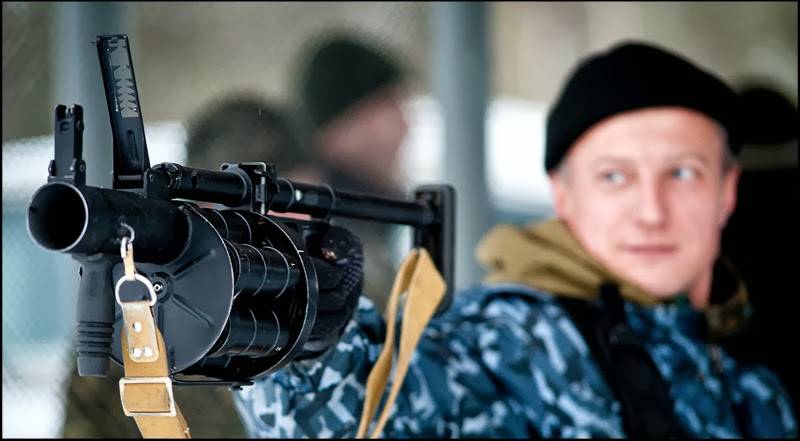
If we talk about efficiency, then, as elsewhere, the main characteristics are laid using the ammunition used, the weapon itself is only a means of delivery to the target. In this article, we approach the question somewhat “behind” and try to examine hand-held grenade launchers in the context of their design, namely hand-held grenade launchers. Well, in order to at least a little equalize them according to the characteristics, we will consider constructions that feed on shots of caliber 40 millimeters.
There will be no comparison and total in the form of a choice of the best revolver-type hand-held grenade launcher, since for such conclusions one must at least have access to all the considered samples with the possibility of checking them on the test site. But you can point to the obvious disadvantages and advantages of the design.
Milkor MGL, or M32 MGL
After the purchase and quite successful use of the M79 American hand-held grenade launchers in South Africa, the countries perplexed the designers: the main shortcoming of such weapons, namely, single-shot, should be eliminated. The solution of the problem was not long in coming, especially since the solution itself has been on the surface and it has been known for more than a dozen years. Taking the revolving power system of weapons as a basis, the designers produced a prototype of a manual grenade launcher in just one year. And two years later, in the 1983 year, mass production of a revolver-type manual grenade launcher, known to us as MGL, had already begun.
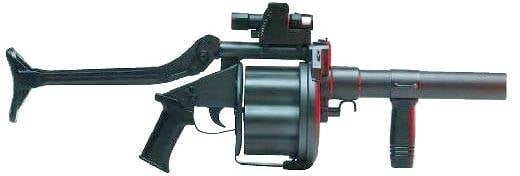
The design of the weapon has been modified several times: in the 1998 year, in 2004 and in 2008. However, nothing fundamentally new was done, except for the fact that in 2004, two versions of weapons with the designations L and S appeared, differing from the first models by the shape of the drum, and from one another by the length of the chamber. It is these grenade launchers that are currently being mass-produced, while in the US Army they are used under the designation М32. It turns out that once the USA gave South Africa their M79, and after a few years South Africa gave the USA M32 MGL. Here is a cycle of hand grenade launchers in nature.
Since at the moment only the versions of the 1998 grenade launchers of the year and 2004 are distributed, we will provide figures for them.
All three variants of grenade launchers are fed from a drum with six cameras, grenade launchers 40x46. The modification of the 1998 grenade launcher of the year is designated MGL Mk.I. Its weight without ammunition is 5,3 kilogram. The length of the weapon varies from 630 to 730 millimeters, depending on how far the butt is advanced, thus fitting the weapon to the body of the shooter. The first versions had a folding up butt of fixed length.
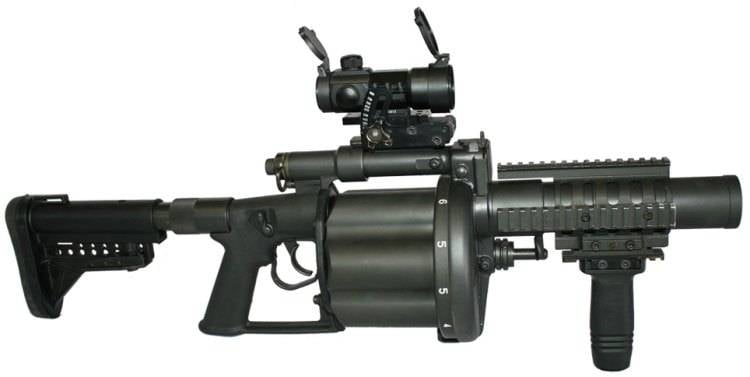
The two versions of the 2004 grenade launchers have the following characteristics. The MGL Mk.IS model boasts a kilogram weight in 5,6. The weapon has grown fat because the drum has been changed, the outer surface of which is now wavy and does not collect pollution. The length with the shifted / apart butt is equal to 674 / 775 millimeters. Option weapons with the letter L in the title. The main difference of this weapon from the two previous models is the elongated drum chambers, which have grown from millimeters to 105 140. Accordingly, the weight of the weapon, which became equal to 6 kilograms, increased, but the manual grenade launcher was able to use a wider range of ammunition. The length of the weapon with the extended / extended butt 674 / 775 millimeters.

It would be useful to clarify that there is another modification of this revolver-type manual grenade launcher dated 2008 by the year, namely the MRGL. As I understand it, this development is no longer just Milkor. This weapon is designed both for the use of standard ammunition, their elongated versions, and 40 x51 shots with a higher flight speed. That is, the weapon, roughly speaking, is the same, and the shots are different. If we look at the grenade launcher externally, then the main thing that differs from its predecessors is the barrel length, which decreased from millimeters to 300 260. Slightly (by 4 of a millimeter) became shorter than the drum chamber, which led to the fact that the weapon could be fed with all ammunition based on the 40х46 grenade launcher and their elongated variants, plus newer “faster” ammunition. At the same time, the dimensions of the hand grenade launcher remained within its “short” versions: 676 and 756 millimeters for the shifted and extended butt.
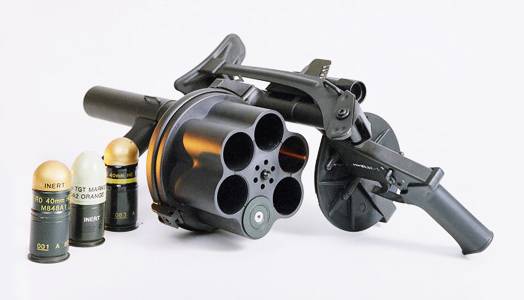
The numbers are good, but the design of this grenade launcher is much more interesting. In the process of working on a new weapon, Milkor designers faced the problem of turning the drum. Such a massive detail did not want to turn as it did in a revolver, under the action of the muscular strength of the shooter, when pressing the trigger or cocking the trigger, and putting a quality expander into each set of weapons was prohibitively expensive. The solution to this problem also turned out to be well known: the triggering of the weapon's barrel with a spring, which is compressed when the grenade launcher is reloaded.
Despite the simplicity of such a solution, the designers of Milkor decided to complicate the scheme of work a little, and at the same time the lives of subsequent users of weapons. Ratchet mechanism of the drum is released at the time of the shot, and the piston, driven by the powder gases of the expelling charge, is responsible for this moment. For the consumer, this meant more complex cleaning of weapons, which is not such a big problem. A much bigger problem is that turning a light drum when shooting does affect the accuracy of firing, and although the grenade launcher is not a sniper rifle at all, this disadvantage still has to be taken into account.
At the moment, a huge amount of ammunition has been developed on the basis of the 40х46 shot, from high-explosive fragmentation to ammunition filled with rubber shot or irritating mucous substances. From the latest developments can be noted a shot in which a camera and a small parachute are placed. In theory, such a device should help focus on the battlefield, giving an idea of the location and movements of the enemy. In practice, the camera lens cannot show a large area of the combat area, since the camera itself is relatively low. In other words, while you look at the muddy picture on the small screen, trying to figure out where the top is, and where the bottom is, the enemy can slowly approach the distance of an outstretched arm.
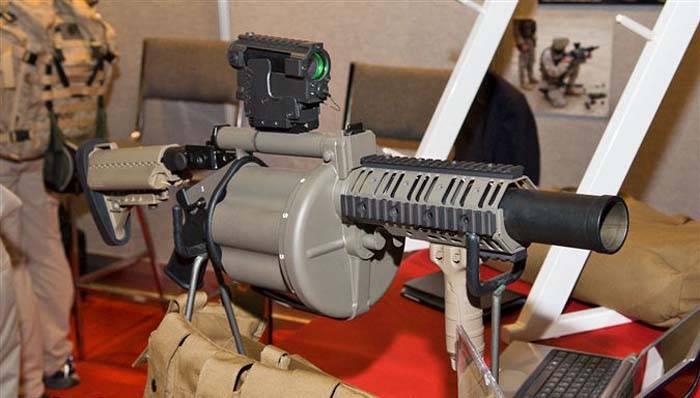
Much more interesting is the grenade shot, which launches the lighting rocket, it only shines in the infrared range of night vision devices, which gives an excellent overview at night. True, if the enemy also has a NVD, then he will see no worse.
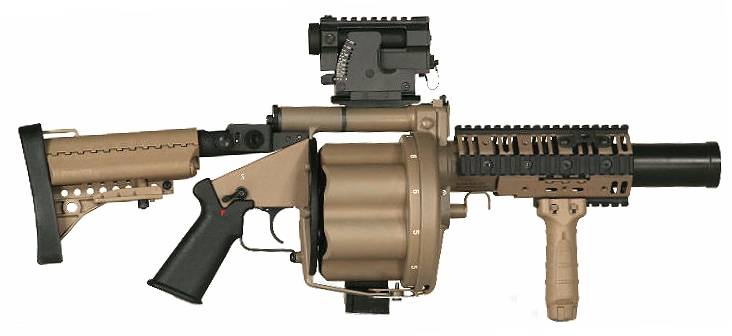
At the moment, MGL hand grenade launchers are widely distributed in NATO countries, and are actively used outside this block. Manufacture is adjusted both in Europe, and in Africa, well and, by itself, in China. This grenade launcher is considered to be the direct and only competitor of the Russian WG-6, often making comparisons, although in this case it’s necessary to compare not so much weapons as ammunition. In addition, the MGL is not the only revolver-type hand-held grenade launcher, although very common.
Hand grenade launcher MM-1
Of course, looking at the success of designers from South Africa, the American gunsmiths could not stay away. In 1985, Hawk Engineering offered its own version of a revolver type grenade launcher. It would be strange to do the same thing as in South Africa, and there were not so many options for improving the design. In this case, we can safely say that the best is the enemy of the good and here's why.
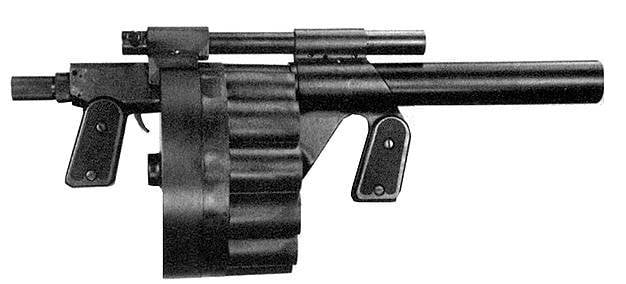
In order to surpass the product of African colleagues, it was decided to make a weapon with a more capacious drum, with half measures in the form of an increase to 7-8. This did not affect the mass of the weapon itself. Thanks to plastic and lightweight alloys, a grenade launcher without shots weighs 12 a kilogram. But if we take 5,7 grams for the mass of a shot, it turns out to be entertaining mathematics: 220 + (5,7 * 0.22) = 12 kilograms.
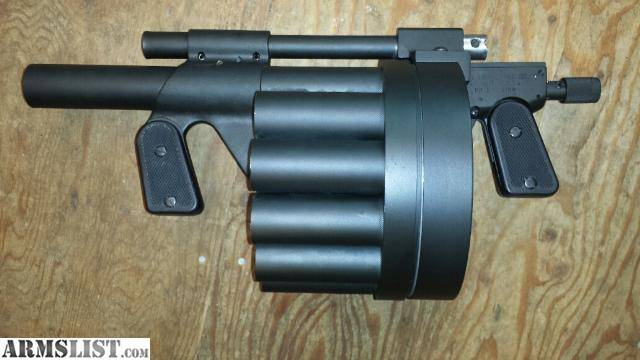
But the mass of weapons - this is not the main drawback, where the mass of the drum with the shots is more important. The basis for this hand grenade was exactly the same system that was used in similar weapons from South Africa. That is, in order for the drum to set in motion during firing, when recharging, the drum spring must be compressed, and the spring is released under the action of the powder gases of the expelling charge. As it is easy to guess, in the construction of the grenade launcher itself the heaviest part is the drum, to which is added the weight of the 12 shots. In the process of shooting, this whole mass will try to move the weapon to the side, which will negatively affect the accuracy of the fire.
The remark that a hand-held grenade launcher is not only not a sniper rifle, but also not a machine gun and with the introduction of amendments to the removal of weapons, as well as with normal aiming before each shot, you can spit on all these negative moments with a high bell tower is quite natural. But there is one detail in this weapon that distinguishes it from both the South African development and all revolver-type hand-held grenade launchers. The MM-1 grenade launcher is able to shoot the queue.
As it is already clear by the number of cameras in the drum of weapons, American designers do not recognize half measures, and if they improve, then improve them in full. The rate of firing small - 150 shots per minute, however, the rotation of the drum, even at this rate of fire will already have a significant impact. In addition, do not forget about recoil in the process of shooting.
The possibility of automatic fire from this weapon would be more than justified when installing such grenade launchers on vehicles, machine tools, and so on, in “manual mode,” as it seems to me, this is rather an irrational expenditure of ammunition.
It would be unfair to say about the shortcomings of the structure, but keep silent about its advantages. As mentioned above, it is possible to overcome the lack of design, when the drum turns right after the shot, which has been proved by quite successful and accurate use of this weapon, so that if you do not find fault, then you can look at it through your fingers. The same construction has one remarkable feature that can be very useful in case of an emergency situation. So, if after pressing the trigger the weapon didn’t react, then you can try to shoot again or wait for the weapon to shoot, in case of a long shot. The situation is rare, but possible, that is, until such time as a shot occurs, the drum remains motionless. If we draw a parallel with the mechanism of the work of WG-6, then there may be options, but more on that below.
As mentioned above, the mass of an unloaded manual MM-1 grenade is equal to 5,7 kilograms. Power is supplied from the drum to the 12 chamber with 40x46 shots, while using longer ammunition is not possible. The length of the weapon is 635 millimeters without stock. Butts can be installed from AR-15 rifles and the like. Recharging is carried out by tilting the back of the grenade launcher to the side with the pistol grip for holding. Just like the other six-model models of grenade launchers, the equipment of the drum comes in one shot, while the coil spring cocks can be made separately.
The weapon turned out to be too overall and quite uncomfortable to transport because of the drum. Despite this, the MM-1 grenade launcher was put into service by the US Army, but it didn’t become widespread and widely known outside the homeland, but in games and films it is a fairly frequent visitor, which creates the wrong feeling of its ubiquitous distribution.
Bulgarian hand grenade launcher "Avalanche", aka Avalanche MSGL
In 1993, the arms company Arsenal finished work on its version of a revolver-type hand grenade launcher. It is obvious that the start of the development was given by the success of a foreign sample from Africa and the beginning of work on similar weapons in Russia. But the principle of “who first got up and sneakers” does not always work on the arms market. Despite the fact that the production of this grenade launcher was started earlier by WP-6, it was not widely used, although it is a very interesting weapon in terms of its characteristics.
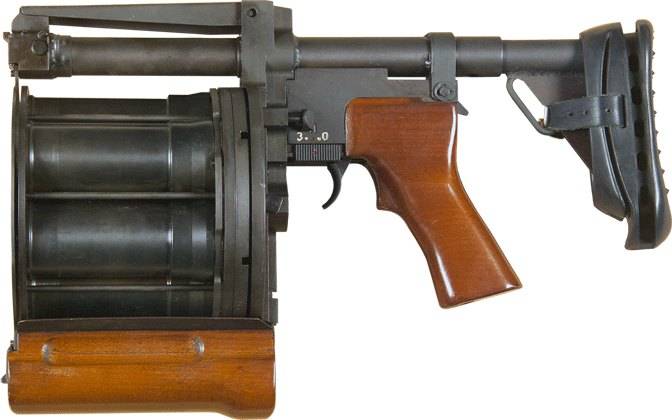
The first thing to note is the very small dimensions of the Avalanche grenade launcher (not to be confused with the Soviet TKB-0218). It is, without exaggeration, the most compact sample of such weapons. Its length with folded butt is just 388 millimeters, with the butt laid out 525 millimeters. Such compact dimensions are explained very simply - the weapon is more likely not of a revolving type, but a pepperbox, that is, it does not have a barrel as a separate part. Having estimated that the length of the drum chamber and the presence of rifling in it is quite enough for the weapon to have at least some accuracy for its niche of use, they decided to remove the barrel from the design. The result of "circumcision" did not significantly affect the combat characteristics of weapons, in short, everything is like that of humans.
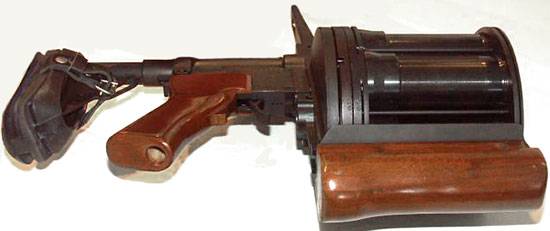
The mass of the grenade launcher after the removal of the barrel did not decrease, since for the convenient holding of the weapon and the firing it was necessary to do the forearm under the drum. The weight of the Avalanche grenade launcher in the discharged position of the 6,3 kilogram, with a full drum mass of the weapon is about 7,8 kilogram. The drum has an 6 chamber, into which VOG-25 shots and others are placed.
A plate with a hole in front of the upper chamber is placed in front of the drum; through this hole both the weapon is discharged and its equipment alternately into each drum chamber. The drum in the process of equipment turns, which compresses the spring, which is the main element that causes the drum in motion in the process of shooting. The discharging of the weapon is again carried out in one shot, for which there is a pusher at the bottom of each chamber when pressed, at which the shot is removed from the weapon. Pressing is done using the button on the left side of the weapon located above the fuse switch.
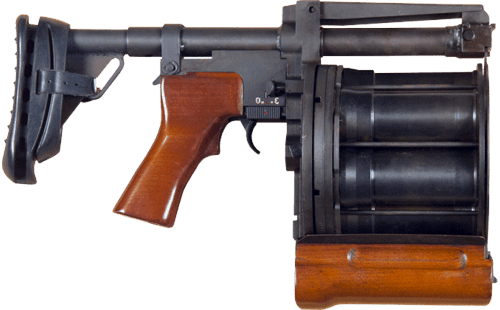
The trigger mechanism of the grenade launcher samovzvodny double action, unfortunately, could not figure out the trigger he or a pistol. The principle of operation of the grenade launcher is similar to that of the WP-6. When the trigger is pressed, the percussion mechanism is cocked and dislodged, which leads to a shot, after the trigger is released by the shooter, the drum spring rotates the drum 60 degrees, substituting a new shot for the striker. Since the grenade-launcher design is “sleeveless,” after the ammunition has been used up, you can immediately start equipping the weapon without wasting time on removing the spent cartridges. However, as the practice of using other grenade launchers shows, such a procedure does not take much time, or rather, it does not take any time at all, since after opening the drum the shells themselves fall under their own weight. The only inconvenience associated with this is to stumble over them.
To ensure a more comfortable perception of recoil by the shooter, the butt of the grenade launcher is equipped with a damper that stretches the recoil moment, in addition to it, a rubber pad is installed on the butt of the weapon, which also plays the role of a shock absorber.
Separately, it should be noted that such a construction of a grenade launcher does not allow making an easy transition of weapons to NATO ammunition standards, where shots have a cartridge case, as a result, it is easier to make a new weapon than trying to modernize the old one.
This grenade launcher is used by both the Bulgarian armed forces and law enforcement agencies in conjunction with non-lethal grenade launchers; this grenade launcher is also offered for export, but is not in great demand.
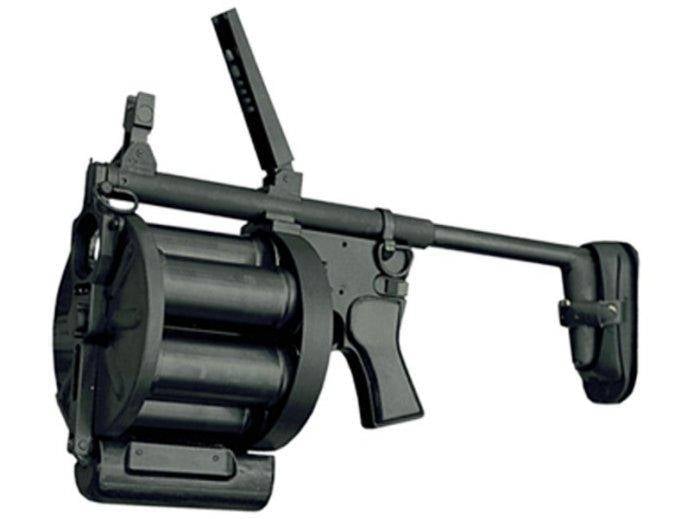
To be objective, the weapons from the Bulgarian designers turned out to be quite good, albeit with an unusual appearance. On the other hand, the grenade launcher does not marry, and if it fully satisfies all the requirements that the military place on it and is reasonably efficient, that is, there is a barrel in it, there is no tenth thing in it. The only drawback, or even rather the feature of the weapon, is that the equipment comes through a hole in the front panel in front of the drum. In other models of grenade launchers, where the drum is tilted to the side, you can pre-compress the spring of the drum, and then alternately insert the shots into the chambers. In the Avalanche grenade launcher, the procedure of turning and equipment alternates, which increases the time for reloading the weapon in comparison with other samples.
Hand grenade launcher WG-6
Well, finally got to the domestic product. The appearance of the RG-6 hand-held grenade launcher in service is due to the designers VN Telesh and B. A. Borzov. It should be noted that the work of designers was quite haste. In November 1993 was assigned a task for a new weapon, and already in March 1994 a test batch of weapons was released, which was immediately sent for testing, and the tests were not limited to the test site, tested the new grenade launcher and in the fighting in Chechnya. There, the grenade launcher received only positive reviews and, taking into account the wishes of the commanders, and the final consumer of weapons, WP-6 began to be mass-produced. Unfortunately, it was not possible to find reliable information about the use of a similar design by the opposing side of grenade launchers, but with all that motley zoo of weapons, there is no doubt that it was, because WP-6 was on the battlefield obviously not superfluous.
If we talk about any specific features or innovations in the design of weapons, then you can not select something. Everything was implemented previously in other samples of a different class, but if you take into account the time spent on developing weapons, it becomes clear that the designers were not required to invent, they were required to do.
You need to start with a grenade drum. The drum consists of a 6 chamber, each of which has X-NUMX grooves. The bottom of the chamber is deaf, there are only openings for the entrance of the drummer and for the ejector rod to defuse the weapon. The drum of the grenade launcher is driven by a torsion coil spring. The spring is twisted by hand, when the drum is equipped with shots. To recharge the drum with the butt and grip for holding rotates upwards.
The barrel of the weapon has no rifling, a simple aiming device is installed on it, and an additional handle to hold it at the bottom.
The trigger-trigger mechanism of the WP-6 grenade launcher is self-cocking, has its own interesting features. The drummer himself is in direct contact with the grenade launcher cap and is held by it in its rear position. With a very small mass of a drummer, such a solution turned out to be quite safe, neither falling nor hitting leads to an unexpected gun shot, but at least one spring was eliminated from the design. The second feature is that after the shot, the drum remains in place, as well as the Bulgarian “Avalanche” grenade launcher, the drum turns when the trigger is released.
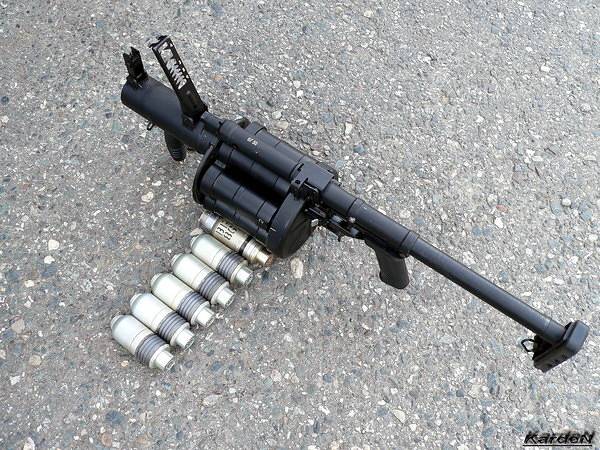
Protection against accidental firing is organized using a fuse switch, plus the whole kind of protection is the force when you press the "trigger". Additionally, the safety of the handling of weapons is provided by an automatic fuse that blocks the trigger when the barrel block is not fully closed.
On the Internet, you can often find stories about how, with a protracted shot, in different variations: a) they killed everyone; b) the guns were thrown away and no one was hurt; c) any other option, up to "a bear ran out of the forest, lay down on a grenade launcher and saved everyone." Stories interesting, colorful, overgrown every time with new details. Indeed, the decision with the turn of the drum during the reverse course of the trigger is not the best in such an unusual situation. Nevertheless, it remains not entirely clear why, knowing such a feature of your weapon, in case of pressing the trigger and not feeling and not seeing the expected result, release this very trigger. If you already let go of the trigger, you can see in the barrel what’s already there, what is it that is stuck.
To reduce the length of the RG-6 hand-held grenade launcher, the butt is made sliding, in the stowed position the length of the weapon is 520 millimeters, in the combat position 680 millimeters. Mass grenade launcher without shots 5,6 kilogram. Sights are designed for firing up to 400 meters, but at maximum distances, for aiming the stock has to be clamped under the armpit. Resource weapons from 2500 to 3000 shots, which is a very good result for a hand grenade launcher.
To be objective, the WG-6 weapon is rather rough. A couple of tubes, a barrel-drum unit and USM from the GP-25, despite this, the grenade launcher is at least not inferior to foreign competitors in anything. The advantage of this weapon is the price, which is significantly lower than the South African counterpart. During its short lifetime, the RG-6 hand-held grenade launcher has shown itself as a weapon that is reasonably reliable and efficient, easy to learn and maintain, though not without drawbacks in the form of small parts that can be lost when servicing the grenade launcher in the field.
Conclusion
I foresee criticism in the designation of individual elements of the weapons referred to in the article. In particular, the designation of the trunk that the trunk is not inherently, but only looks like it. For example, in the same WP-6, the sights and the grip for holding are located on the false barrel, while the drum's cavities are barrels with rifled parts. There is nothing to parry, except the arrangement of these elements in the design. Therefore, it is more correct, probably, to designate such grenade launchers not as a revolver-type weapon, but as a peperbox-type grenade launcher, but it seems to me that this is not such an important nuance that should be emphasized.
As is clear from the article, revolver-type grenade launchers under forty-millimeter shots are a demanded weapon, but there is no such diversity as in other classes. The designs themselves are distinguished by maximum simplicity and low cost, which can be explained by the cost of shots. With expensive shots and weapons are expensive - a luxury. Despite this, gunsmith designers still have much to do in improving the already created models, and in developing new designs. The main disadvantage of revolver-type grenade launchers is their slow reloading in one shot, which still needs to be individually extracted. That is, even in the direction of the development of additional devices there is where to go.
Separately, it should be said about the nomenclature of ammunition. Despite the fact that most of the shots developed on the basis of 40x46, not all succeed, one option for a dozen "shoots" and is adopted. It would seem that with the current abundance of options for domestic grenade launchers, all niches of use have been blocked, but no one has forbidden to strive for more. Cameras on parachutes down is, of course, overkill, but there is still much to strive for, since at this moment we are already lagging behind in this regard.
Sources of photos and information:
weaponland.ru
modernweapon.ru
forum.guns.ru
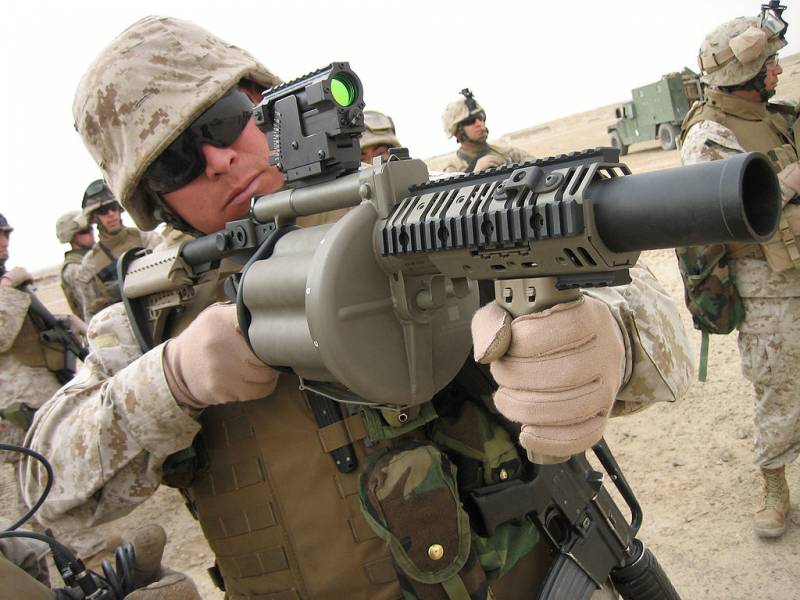
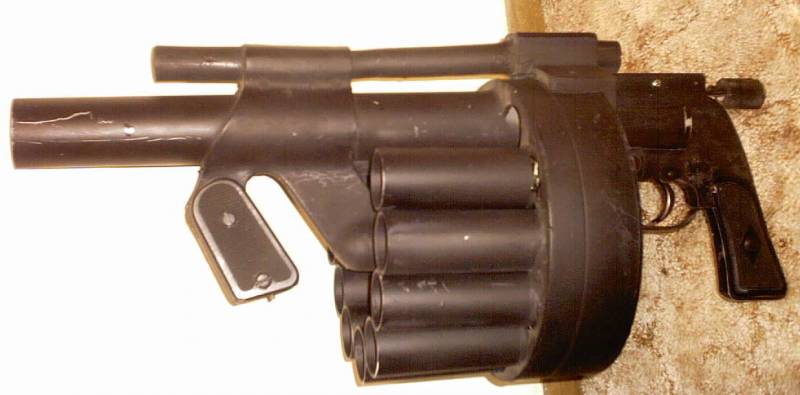
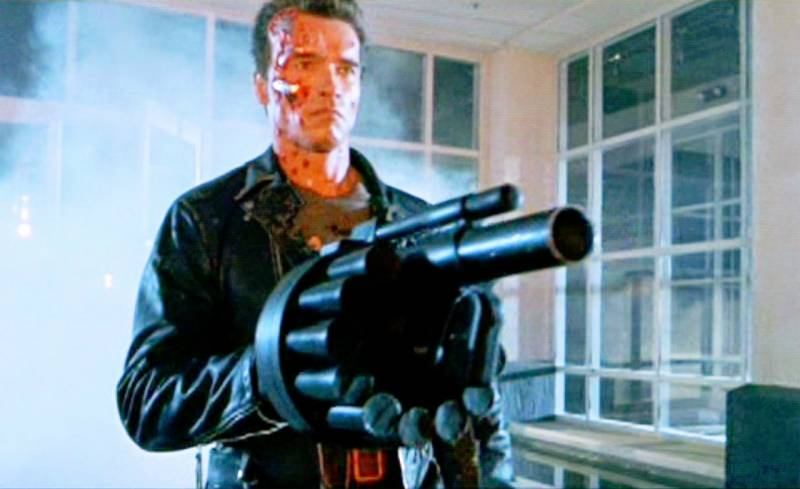
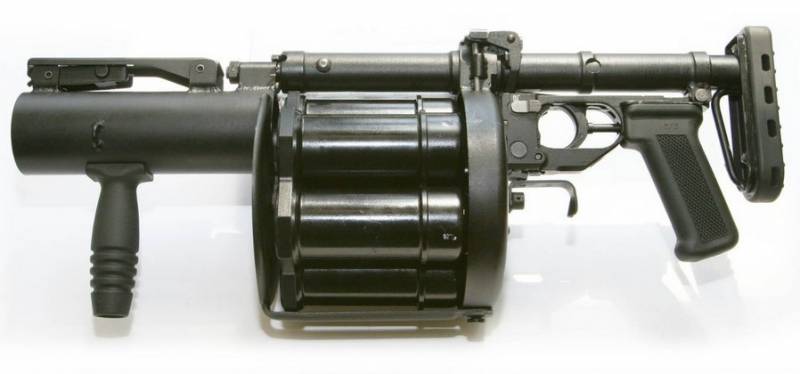
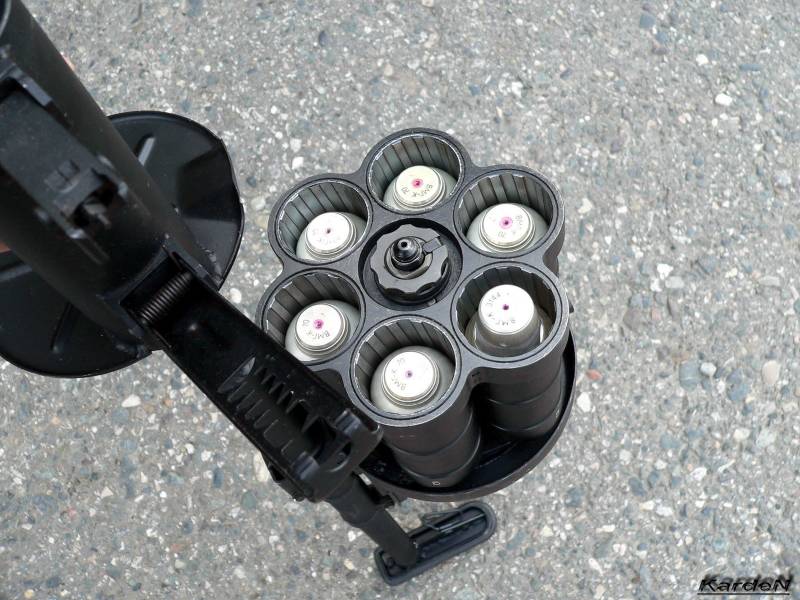
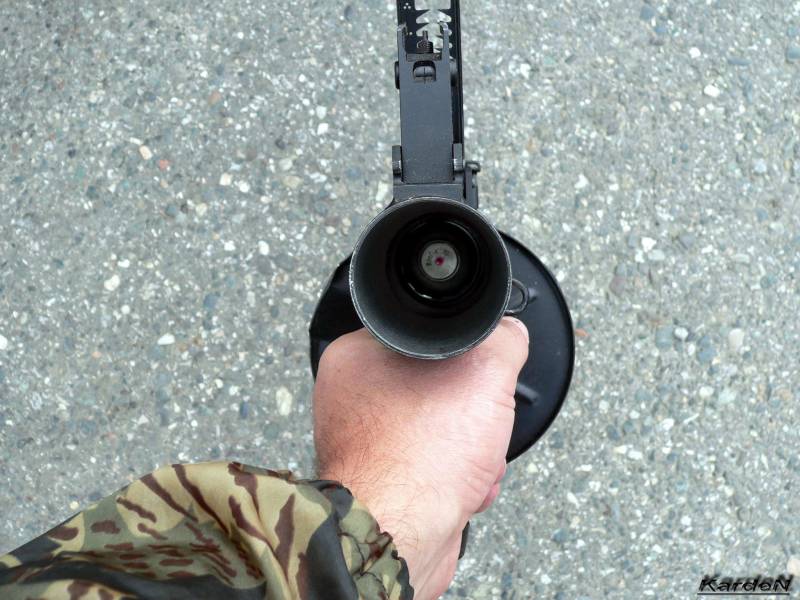

Information